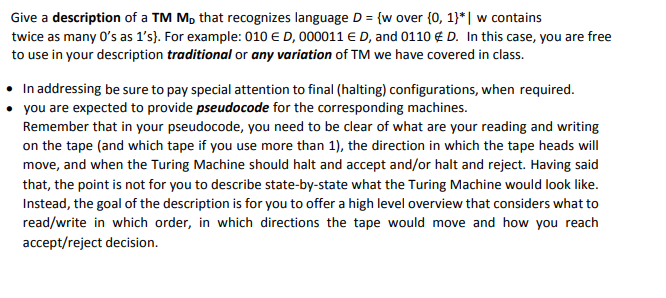Give a description of a TM M, that recognizes language D = {w over {0, 1}*| w contains twice as many O's as 1's}. For example: 010 € D, 000011 € D, and 0110 € D. In this case, you are free to use in your description traditional or any variation of TM we have covered in class. In addressing be sure to pay special attention to final (halting) configurations, when required. you are expected to provide pseudocode for the corresponding machines. Remember that in your pseudocode, you need to be clear of what are your reading and writing on the tape (and which tape if you use more than 1), the direction in which the tape heads will move, and when the Turing Machine should halt and accept and/or halt and reject. Having said that, the point is not for you to describe state-by-state what the Turing Machine would look like. Instead, the goal of the description is for you to offer a high level overview that considers what to read/write in which order, in which directions the tape would move and how you reach accept/reject decision.
Give a description of a TM M, that recognizes language D = {w over {0, 1}*| w contains twice as many O's as 1's}. For example: 010 € D, 000011 € D, and 0110 € D. In this case, you are free to use in your description traditional or any variation of TM we have covered in class. In addressing be sure to pay special attention to final (halting) configurations, when required. you are expected to provide pseudocode for the corresponding machines. Remember that in your pseudocode, you need to be clear of what are your reading and writing on the tape (and which tape if you use more than 1), the direction in which the tape heads will move, and when the Turing Machine should halt and accept and/or halt and reject. Having said that, the point is not for you to describe state-by-state what the Turing Machine would look like. Instead, the goal of the description is for you to offer a high level overview that considers what to read/write in which order, in which directions the tape would move and how you reach accept/reject decision.
Database System Concepts
7th Edition
ISBN:9780078022159
Author:Abraham Silberschatz Professor, Henry F. Korth, S. Sudarshan
Publisher:Abraham Silberschatz Professor, Henry F. Korth, S. Sudarshan
Chapter1: Introduction
Section: Chapter Questions
Problem 1PE
Related questions
Question
100%

Transcribed Image Text:Give a description of a TM M, that recognizes language D = {w over {0, 1}*| w contains
twice as many 0's as l's}. For example: 010 E D, 000011 E D, and 0110 € D. In this case, you are free
to use in your description traditional or any variation of TM we have covered in class.
• In addressing be sure to pay special attention to final (halting) configurations, when required.
you are expected to provide pseudocode for the corresponding machines.
Remember that in your pseudocode, you need to be clear of what are your reading and writing
on the tape (and which tape if you use more than 1), the direction in which the tape heads will
move, and when the Turing Machine should halt and accept and/or halt and reject. Having said
that, the point is not for you to describe state-by-state what the Turing Machine would look like.
Instead, the goal of the description is for you to offer a high level overview that considers what to
read/write in which order, in which directions the tape would move and how you reach
accept/reject decision.
Expert Solution
This question has been solved!
Explore an expertly crafted, step-by-step solution for a thorough understanding of key concepts.
This is a popular solution!
Trending now
This is a popular solution!
Step by step
Solved in 2 steps

Knowledge Booster
Learn more about
Need a deep-dive on the concept behind this application? Look no further. Learn more about this topic, computer-science and related others by exploring similar questions and additional content below.Recommended textbooks for you

Database System Concepts
Computer Science
ISBN:
9780078022159
Author:
Abraham Silberschatz Professor, Henry F. Korth, S. Sudarshan
Publisher:
McGraw-Hill Education

Starting Out with Python (4th Edition)
Computer Science
ISBN:
9780134444321
Author:
Tony Gaddis
Publisher:
PEARSON

Digital Fundamentals (11th Edition)
Computer Science
ISBN:
9780132737968
Author:
Thomas L. Floyd
Publisher:
PEARSON

Database System Concepts
Computer Science
ISBN:
9780078022159
Author:
Abraham Silberschatz Professor, Henry F. Korth, S. Sudarshan
Publisher:
McGraw-Hill Education

Starting Out with Python (4th Edition)
Computer Science
ISBN:
9780134444321
Author:
Tony Gaddis
Publisher:
PEARSON

Digital Fundamentals (11th Edition)
Computer Science
ISBN:
9780132737968
Author:
Thomas L. Floyd
Publisher:
PEARSON

C How to Program (8th Edition)
Computer Science
ISBN:
9780133976892
Author:
Paul J. Deitel, Harvey Deitel
Publisher:
PEARSON

Database Systems: Design, Implementation, & Manag…
Computer Science
ISBN:
9781337627900
Author:
Carlos Coronel, Steven Morris
Publisher:
Cengage Learning

Programmable Logic Controllers
Computer Science
ISBN:
9780073373843
Author:
Frank D. Petruzella
Publisher:
McGraw-Hill Education